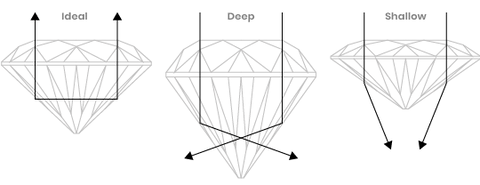The 4Cs
Diamond Cut
The cut of a diamond not only refers to the diamond’s shape, it also refers to how effectively the diamond returns light back to the viewer’s eye. A well-cut diamond will appear very brilliant and fiery, while a poorly cut diamond can appear dark and lifeless, regardless of its color or clarity.
The diamond cut is the most important element to consider when buying a diamond. The cut is the biggest factor in creating sparkle and fire, and without a high cut grade even a diamond of high quality can appear dull and lifeless. A diamond cut poorly and too deep can face-up smaller than it actually is. Use our buying tips, diamond cut grading scale and comparison chart, and expert tips to help you choose the best diamond cut for your budget.

Buying Tip
- Cut is the most important of the 4Cs because it has the greatest influence on a diamond’s sparkle.
- Even if a diamond has a perfect clarity and color grade, if it has a poor cut, it may appear dull.
- When diamond cuts are made with the proper proportions, light is returned out of the top of the diamond (which gemologists refer to as the table). If the cuts are too shallow, light leaks out of the bottom; too deep and it escapes out of the side.
- To maximize your budget, choose the highest diamond cut grade your budget allows. We suggest a cut grade of Very Good or better.
Diamond Color
After diamond cut, diamond color is the second most important characteristic to consider when choosing a diamond. The highest quality diamonds are colorless, while those of lower quality have noticeable color, which manifests as pale yellow in diamonds.
The Gemological Institute of America (GIA) grades diamond color on a scale of D (colorless) to Z (light yellow or brown). D-Z diamonds are also known as white diamonds, even though most diamonds, including H color diamonds and G color diamonds, have varying amounts of color.


Buying Tip
If you’re looking to buy fine diamond jewelry such as an engagement ring, it’s important to understand how diamond color affects price. Here are a few buying tips and things to know about diamond color.
- When it comes to diamonds, less color means higher quality. While brilliance is the first thing you notice about a diamond, color is the second. The higher the color grade, the less color there is, and the more expensive it will be.
- For the best value, choose G-J diamond color grades in the Near Colorless category. With these diamonds, the naked eye can’t discern any color. The visible difference between diamonds of one color grade (G-H or I-J) is so minor it’s difficult to detect with the unaided eye, but the cost savings can be significant. Keep this in mind when choosing your diamond color grade.
- In general, to avoid a pale yellow color, choose a diamond grade H or higher. For the purist, look for a D to F grade colorless diamond, which will have no discernible color under magnification.
- Diamond shape, size and your ring’s metal setting can visually impact diamond color.
- Ring Setting — Pairing diamonds with similar toned metals can neutralize color in the diamond. Consider setting higher color grade diamonds like Near Colorless diamonds (G-J) in yellow gold and Colorless diamonds (D-F) in white gold or platinum. A gold setting may show through a colorless diamond.
-
Diamond Shape — Some diamond shapes may show or mask color to varying degrees. For example, brilliant-cut shapes such as round and princess reflect more light, which means more color is masked. Step-cut diamonds (emerald and Asscher cuts) may show more color because they are cut with fewer facets, resulting in bigger “windows” through which to see the color.
Fancy shaped diamonds, like pear and marquise may also show slightly more concentrated color at their points. - Diamond Size — Color is easier to see in larger diamonds. If you want a diamond above 1 carat, choose a G or H colored diamond. I-J color diamonds are best when just under a carat.
Diamond Clarity
Diamond clarity is the assessment of small imperfections on the surface and internally. The surface flaws are called blemishes, and internal defects are known as inclusions. These tiny, natural blemishes and inclusions are microscopic and do not affect a diamond’s beauty in any way. Diamonds with the least and smallest inclusions receive the highest clarity grades.
Clarity is one of the 4Cs of diamond grading and quality. Diamond clarity is the least important factor when choosing to buy a diamond because most diamonds have blemishes and small inclusions that are microscopic, unable to be seen with an untrained or unaided eye.


Carat (Size)
Diamond carat is often misunderstood and refers to a diamond’s weight, not necessarily its size. When comparing diamond carat sizes, take a diamond’s cut into consideration as well: a high-carat diamond with a poor cut grade may look smaller, often cut deeper, than a diamond with smaller carat weight and a better cut. Use our buying tips, diamond carat size chart, and expert tips to help you choose the best diamond carat weight for you.


 Start with a setting
Start with a setting
 Solitaire
Solitaire Pavé
Pavé Channel-Set
Channel-Set Halo
Halo Side-stone
Side-stone Platinum
Platinum
 Yellow Gold
Yellow Gold
 Rose Gold
Rose Gold
 White Gold
White Gold
 Classic Wedding Bands
Classic Wedding Bands
 Eternity Bands
Eternity Bands
 Diamond Bands
Diamond Bands
 Stackable Bands
Stackable Bands
 Carved Bands
Carved Bands
 Alternative Metal Bands
Alternative Metal Bands
 Eternity Bands
Eternity Bands
 Anniversary Rings
Anniversary Rings
 Diamond Studs
Diamond Studs
 Diamond Pendants
Diamond Pendants
 Tennis Bracelets
Tennis Bracelets
 Earrings
Earrings
 Gemstone Earrings
Gemstone Earrings
 Pearl Earrings
Pearl Earrings
 Gemstone Necklaces
Gemstone Necklaces
 Pearl Necklaces
Pearl Necklaces
 Diamond Bracelets
Diamond Bracelets
 Gemstone Bracelets
Gemstone Bracelets
 Diamond Rings
Diamond Rings
 Gemstone Rings
Gemstone Rings







Leave a comment